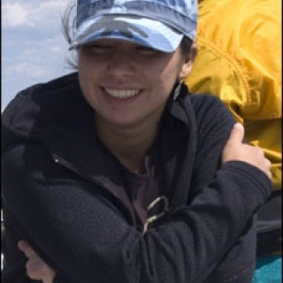Eight students will be presenting the summer work at the Ocean Sciences Meeting in March 2022!
Keala Cummings, Scripps College
Class Year:
2008Mentor:
Lora Harris, Ph.D.Project Title:
Investigation of the Impact of Vegetation Type on Sedimentation Rates in a Freshwater Tidal Wetland, Jug Bay, Maryland, USA
Abstract:
A pilot study to investigate the effects of emergent freshwater wetland vegetation on sedimentation rates evaluated the impact of species composition, morphology, and distance from sediment source on accretion rates. Two transects were situated perpendicular to tidal creeks in the Jug Bay Wetland Sanctuary; one representing a diverse plant community composed predominantly of spatterdock (Nuphar advena), arrow arum (Peltandra virginica) and narrow leaf cattail (Typha angustifolia), and the other site dominated exclusively by spatterdock. Individual plants were collected along each transect to measure morphology, dry weight, and sediment captured on the surface of leaves and stems. Plant community measurements of percent cover, density, and biomass were also collected. Individual plant surface area or distance from tidal creek did not explain sediment capture rates. However, calculations of projected frontal area of the vegetation from plant density, water volume, and surface area estimates were related to increasing sediment capture in the spatterdock and arrow arum communities. Accretion rates attributable to plant capture were estimated using published bulk density values from the same locations and ranged from 0.7 mm year-1 for spatterdock to 0.33 and 0.39 mm year-1 for the low and middle marsh plant communities. High rates of sedimentation in spatterdock communities coincide with the lowest elevation zone of the marsh platform most susceptible to sea level rise.
Location:
Chesapeake Biological LaboratoryPresentations:
Cummings, K.*, and L. Harris. 2009. Investigation of the impact of vegetation on sediment rates in a fresh water tidal wetland, Jug Bay, Maryland . Coastal and Estuarine Research Federation 20th Biennial Conference, Portland, Oregon .





